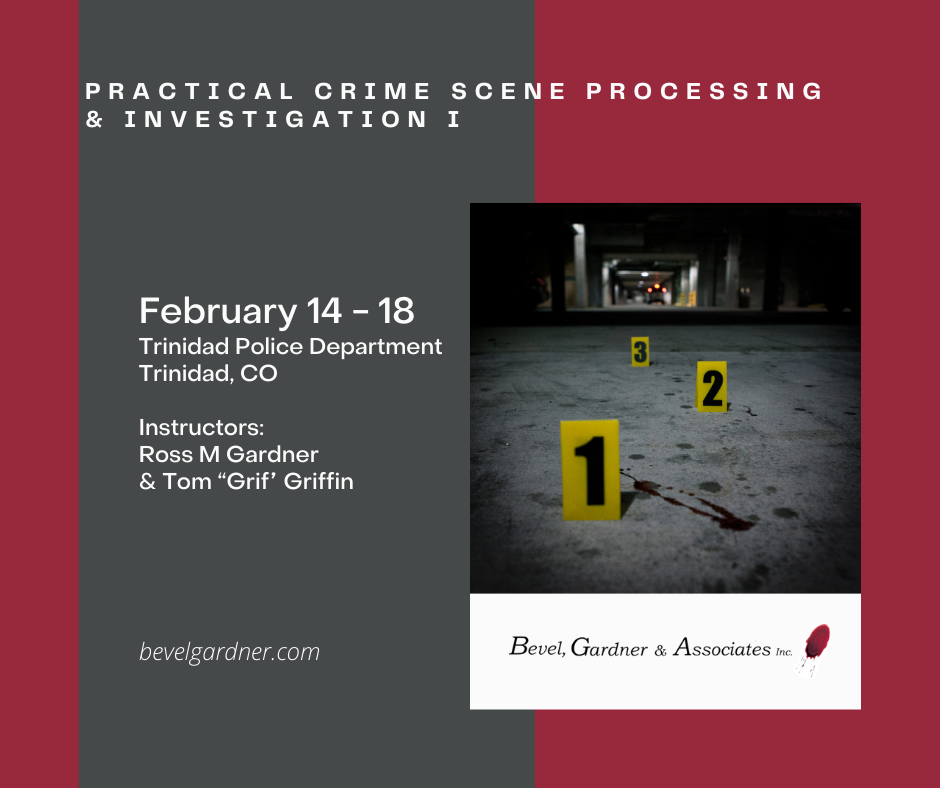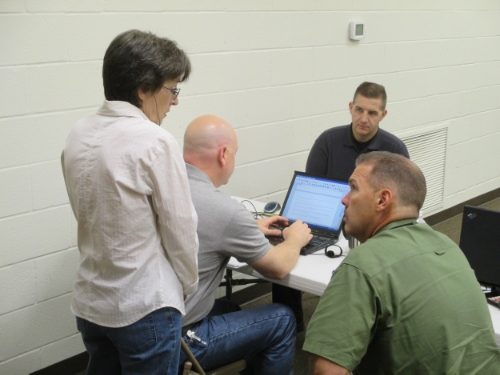Crime Scene Processing in Trinidad, CO and Upcoming Courses for spring 2022
Read MoreBlog
Bevel Gardner & Associates forensic consulting and education providing instruction across the country and around the world. Located in Oklahoma, we are the largest independent forensic consulting company in the US. Follow our blog.
New Year, New Training - Bevel, Gardner & Associates Expert Training Courses
The BPAPD program incorporates three distinct training courses of one week each. A Level I course introduces the student to bloodstain pattern analysis with significant concentration on basic pattern recognition and documentation. This Level II course concentrates on proper application of scientific method, experimental design and clothing examinations. Between the Level II and Level III course the student participates in a mentorship program. The mentoring program includes requirements for both case analysis and research design/completion. The Level III course includes a pre-course case analysis and then on-site course concentration on experimental design, and court room presentations.
Objectives:
Demonstrate the ability to use and apply scientific method.
Demonstrate the ability to apply experimental design in support of bloodstain pattern analysis.
Demonstrate the ability to evaluate bloodstain patterns on clothing.
Recognize and demonstrate how Luminol and LCV are used to enhance latent blood patterns.
Demonstrate the ability to evaluate a complex bloodstain pattern scene.
Demonstrate the ability to present bloodstain pattern analysis conclusions in a logical written format.
The course is intended to develop a fundamental knowledge of crime scene processing technique. The course will illustrate to the student the six basic activities of crime scene processing and the sequence of those activities. The course concentrates on these core concepts: assessing, observing, documenting, searching and collecting, but also includes lectures on advanced techniques such as alternate light source utilization, bloodstain pattern recognition and trajectory analysis. It will introduce the student to the function and role of crime scene analysis.
Objectives:
Demonstrate knowledge of the six basic activities involved in crime scene processing and the general order of these activities.
Recognize the general categories of physical evidence, what a crime laboratory can do with this evidence and accepted methods of recovery.
Demonstrate knowledge of the critical aspects of assessing a crime scene, including scene containment, crime scene team composition considerations, choosing the most effective crime scene search technique and scene hazard identification and mitigation.
Describe the different scene mapping methods.
Describe the three basic photographs utilized for crime scene documentation.
Describe and demonstrate the basic elements of crime scene narratives.
Recognize basic bloodstain patterns.
Discuss the function, theory and application of an alternative light source in crime scene processing.
Recognize the affect of effective crime scene documentation on crime scene analysis.
Describe basic methodologies of crime scene analysis.
Ross Gardner Recreates the Scene of Horrific Mass Murder While Testifying to King County Prosecution
Find out about Bevel Gardner's most recent crime scene recontruction case.
Read MoreLA IAI Annual Training Conference
Ross spent the 10 and 11th of June in Lake Charles, LA presenting two workshops for the LA IAI annual training conference. First up on Wednesday was a four-hour workshop on methodology for crime scene reconstruction. After a 1.5 Hr lecture, student participants were required to apply the concepts presented to evaluate an actual homicide case and decide if they could refute or corroborate a testimonial claim by a subject. On Thursday a shooting incident reconstruction (SIR) workshop was on the agenda. Once again, following a lecture, students were presented with a hypothetical police shooting and applying basic SIR concepts asked to refute or corroborate two different claims about the incident.
Students Sharpen Analysis Skills Through Crime Scene Reconstruction Class
This Crime Scene Reconstruction Level II course took place in Conroe, Texas.
Ross and Iris just completed a Level II Crime Scene Reconstruction course hosted by the Montgomery County Sheriff’s Office in Conroe, Texas. Class participants included primarily members of the MCSO Major Crimes Unit and the MCSO Crime Lab as well as students from the Plano Police Department and USAF Office of Special Investigations.
The Level II course concentrates on demonstrative evidence in support of crime scene reconstruction and includes evaluation of a major case. In the photos the students are developing their reports, demonstratives aids and investigative worksheets to support their major case analysis.
These students will now be able to demonstrate proper use of the Event Analysis technique to define objective information about a criminal incident. They will also be able to properly articulate their analysis to a jury.
Are You the Weak Link?
There is an old saying that a chain is only as strong as it’s weakest link. In forensic science, that weak link is often the crime scene investigator.
Read MoreMore from Singapore
Ross Gardner completed a two-week presentation on Crime Scene Reconstruction (CSR) I and II with an emphasis on Bloodstain Pattern Analysis. The course was conducted for the Health Services Authority (HSA) of Singapore’s Forensic Laboratory. Students included eleven forensic analysts of varying experience levels. Bevel, Gardner & Associates' hosts were Peter Wilson and Dr. Yee Wee Chuan, who hope to develop a more robust protocol to follow for conducting reconstructions in Singapore. Prior students from HSA had attended the CSR I course and introduced the Event Analysis methodology to both the laboratory and the Singapore criminal justice system.
Dubai Training
Dubai, UAE
Jon and Ross were recently requested by the Dubai Police Department to conduct Crime Scene Reconstruction training. Our experts traveled to the United Arab Emirates between December 8th-19th to present both Level I and Level II Crime Scene Reconstruction Training courses. We were excited to see so many different areas of the Dubai Police forces in attendance. Representatives included Medical Examiners, Crime Scene Investigators, Criminal Investigators from the General Department of Criminal Investigation, as well as scientists from their forensics lab.









